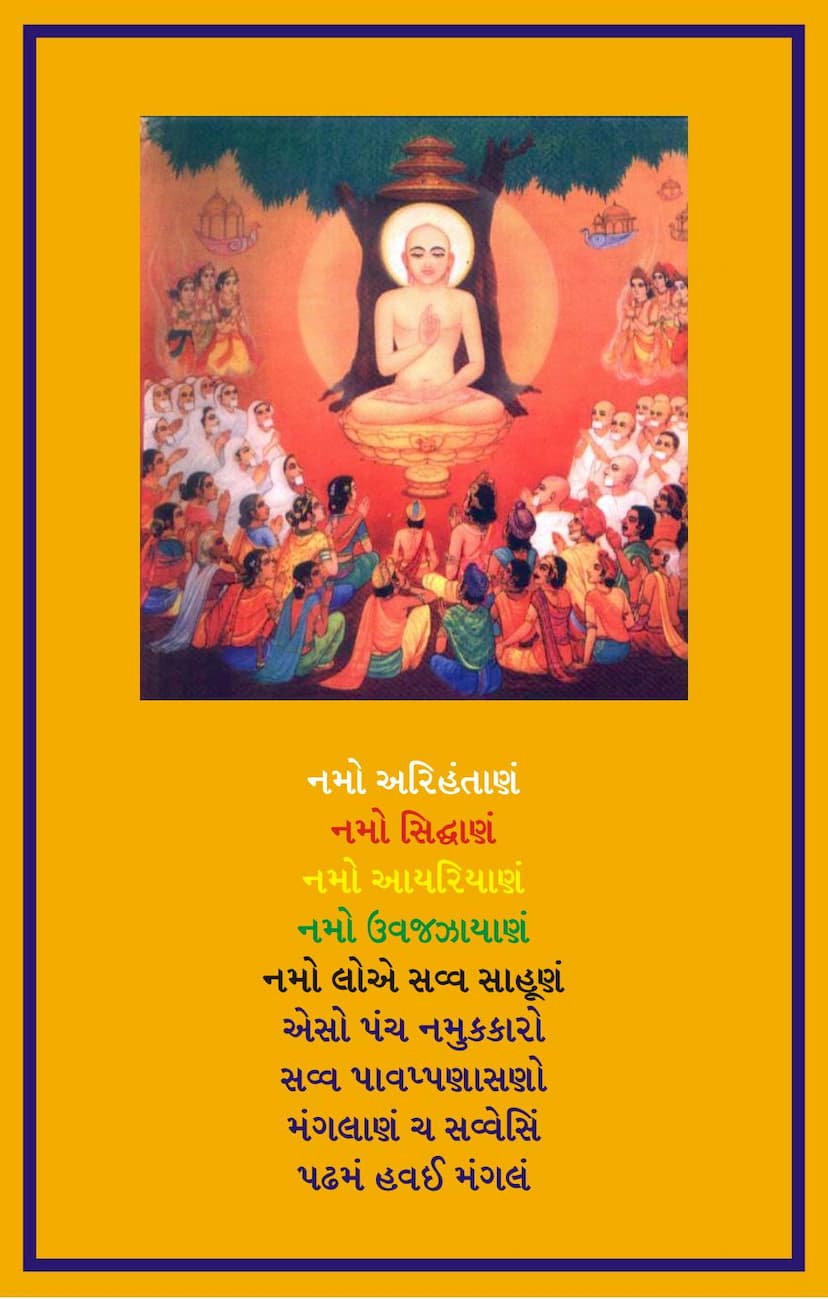Agam 08 Ang 08 Antkrut Dashang Sutra Sthanakvasi
Added to library: September 1, 2025

Summary
This is a comprehensive summary of the Jain text provided, focusing on its content and structure as presented in the text itself, particularly the "Muni Kumud Chandrika" commentary by Ghasilal Maharaj.
Book Title: Agam 08 Ang 08 Antkrut Dashang Sutra Sthanakvasi Author: Ghasilal Maharaj Publisher: A B Shwetambar Sthanakvasi Jain Shastroddhar Samiti Catalog Link: https://jainqq.org/explore/006336/1
Overview:
The text is the eighth Anga (part) of the Agam literature in Jainism, specifically the "Antakrit Dashang Sutra" (also referred to as Antagad Dasao or Antakruda Dasao). This particular edition is presented with a commentary titled "Muni Kumud Chandrika" by Ghasilal Maharaj and includes Hindi and Gujarati translations. The publisher is the Akhil Bharat Shwetambar Sthanakvasi Jain Shastroddhar Samiti. The text details the lives and spiritual journeys of individuals who achieved liberation (moksha) in their very lifetime, having attained omniscience (Kevalgyan) through rigorous ascetic practices.
Key Components and Content:
-
Mangalacharan (Invocation): The text begins with the Panch Parmeshthi Namaskar (Navkar Mantra), a fundamental prayer in Jainism.
-
Foreword and Publisher's Information: Pages 2-5 provide details about the publication, including the visionary behind the project (Shri Chandra P. Doshi), the esteemed Acharya Ghasilalji Maharaj, and the publishers. It also mentions the second edition was printed in Vikram Samvat 2014 (1958 CE) with 1000 copies.
-
Instructions for Swadhyaya (Study): Pages 6-10 provide detailed guidelines on the auspicious times and circumstances for studying the original text. It outlines 32 situations of "Aswadhyaya" (times when study is prohibited), categorized into 10 related to the physical body (Audarik Sharir) and 10 related to cosmic phenomena (Akash Sambandhi). These include times like meteor showers, eclipses, periods of intense natural phenomena, and times of death or impurity. It also emphasizes that these rules are primarily for the original text, not necessarily for translations.
-
Vishayanukramanika (Table of Contents): Pages 11-16 provide a detailed table of contents, outlining the structure of the Antakrit Dashang Sutra, which is divided into eight Vargas (sections) and ninety Adhyayanas (chapters). The table lists the key individuals and events covered in each section, including:
- First Varga: Gautam, Samudra, Sagar, Gambhir, Stimita, Achal, Kampilya, Akshobh, Prasen Kumar, and Vishnu Kumar.
- Second Varga: Akshobh, Sagar, Samudra, Himavan, Achal, Puraya, Abhichandra, and other Kumars.
- Third Varga: Aniyasen, Anantansen, Ajitsen, Anihatharipu, Devsen, Shatrusen, Saran, Gajsukumar, Sumukh, Durmukh, Kupak, Daruk, and Anadrishti.
- Fourth Varga: Jali, Mayali, Upayali, Purushsen, Varisena, Pradyumna, Shamb, Aniruddha, Satyanemi, and Dhadhanemi.
- Fifth Varga: Padmavati, Gauri, Gandhari, Lakshmana, Susheema, Jambavati, Satyabhama, Rukmini, Mulashri, and Muldatta.
- Sixth Varga: Mankai, Kinkam, Mudgarpani (Arjunmali), Kashyap, Kshemak, Dhritidhar, Kailas, Harichandan, Varat, Sudarshan, Purnabhadra, Sumanabhadra, Supratishtha, Megh, Atimukta (Evanta), and Alakshya.
- Seventh Varga: Nanda, Nandmati, Nandottara, Nand Sena, Mahaya, Sumruta, Mahamaruta, Marudevi, Bhadra, Subhadra, Sujata, Sumati, and Bhutadinnā.
- Eighth Varga: Kali, Sukali, Mahakali, Krishna, Sukrishna, Mahakrishna, Veerkrishna, Ramkrishna, Ptrusena Krishna, and Mahasena Krishna.
-
Content Summary of Each Varga: The subsequent pages (18-32) provide a summary of the narratives within each of the eight Vargas, highlighting the lives and spiritual achievements of the individuals mentioned in the table of contents. Notable narratives include:
- Gautam: His marriage, hearing the sermon of Lord Arishtanemi, renunciation, rigorous penance, and attainment of Kevalgyan.
- Other Kings and Princes: Summaries of the renunciations and spiritual paths of various princes and kings who achieved liberation.
- Six Anagars: A detailed account of six disciples of Lord Arishtanemi, their unique penances, and the story of Devki Rani's maternal feelings.
- Gajasukumar: His story of forgiveness, enduring extreme suffering, and attaining Kevalgyan.
- Krishna Vasudev: His conversation with Lord Arishtanemi about the destruction of Dwarka and his future as the 12th Tirthankar.
- Padmavati: Her renunciation and spiritual attainment after Lord Arishtanemi's sermon.
- Arjunmali: His story of delusion, being possessed by the Yaksha Mudgarpani, his subsequent acts of violence, and eventual renunciation and liberation after hearing Lord Mahavir's sermon.
- Sudarsan: His devotion and renunciation.
- Other Royal Figures and Queens: Summaries of the lives of numerous queens and royal figures who attained liberation.
- The Eight Queens (Kali, Sukali, etc.): Details of their ascetic practices and eventual liberation.
-
Praise and Testimonials: Pages 33-46 contain numerous testimonials and letters of appreciation from various esteemed Jain Acharyas, Mahasatis, professors, and scholars. These commend the immense effort and scholarly contribution of Acharya Ghasilalji Maharaj in bringing these sacred texts to light with detailed commentaries and translations. They highlight the usefulness and devotional value of this work for the Jain community.
-
Appeal for Support: Page 16 contains an appeal to the community for cooperation and support in this noble endeavor of scriptural revival, emphasizing the rarity of such opportunities.
-
Overall Theme: The core message of the Antakrit Dashang Sutra, as highlighted in the text, is the path to liberation through the combined practice of "Gyan" (knowledge) and "Kriya" (action/practice). It emphasizes the lives of individuals who, through their unwavering devotion, asceticism, and virtuous conduct, achieved complete victory over karmas and attained Moksha in their own lifetime. The commentary aims to make these profound teachings accessible to a wider audience.
Key Figures:
- Lord Mahavir Swami: The central religious authority whose teachings are expounded.
- Lord Arishtanemi: Another Tirthankar whose teachings are also referenced.
- Lord Sudharmaswami: The disciple who received the teachings from Lord Mahavir and transmitted them.
- Lord Jambu Swami: The recipient of Sudharmaswami's teachings and the one to whom the commentary is primarily directed.
- Acharya Ghasilal Maharaj: The author of the commentary, revered for his scholarship and dedication to Jain literature.
- Various Kings, Queens, Princes, and Anagars (ascetics): The central characters whose lives of renunciation and spiritual pursuit are narrated.
This summary aims to capture the essence and structural organization of the provided text, highlighting its spiritual significance and the monumental effort involved in its publication and commentary.